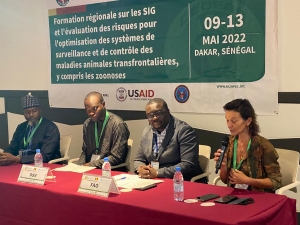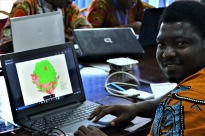Wildlife and biodiversity help to keep ecosystems healthy, which supports sustainable food systems and agriculture. Conservation and sustainable wildlife management contribute to reducing hunger and poverty.
Wildlife, livestock, humans, and the environment are all highly connected. It is important to understand how diseases spill over between species, transmit and spread, in order to protect wild and domestic animals, as well as humans. This will strengthen our shared ecosystems, and ultimately safeguard human health, livelihoods and food security (see also FAO's Sustainable Wildlife Management Programme).
FAO animal health applies a One Health approach to support understanding around certain diseases and interventions at the interface with wildlife, including the prevention of diseases passing from wildlife to domestic animals and humans. See Evidence-based actions below.
A connected and changing world
The interaction between humans, livestock and wildlife is increasing.
This increased contact offers pathogens an opportunity to infect new host species. Wildlife species, including bats, primates and rodents are a source of diverse microbes and an important reservoir of emerging infectious disease agents.
Deforestation, exploitation of natural resources, expanse of urban areas into rural land or grazing in fields shared with wildlife, all increase contact between humans, livestock and wild animals. Food insecurity can lead to movement of people and domestic animals across areas with more wildlife, or an increase in hunting wildlife for food.
This interface is not only being enhanced by humans encroaching on wild habitats, but also by wildlife living in human-dominated environments or being forced to move towards urban areas due to habitat loss, extreme weather events or fires. Climate change is also leading to the geographical ranges of wild species contracting, expanding, or shifting to new areas – where they may come into contact with humans and livestock, and introduce pathogens for the first time. A warmer climate also leads to an expansion of pests and disease vectors such as mosquitos.
This increased interaction leads to greater risk of new infectious diseases ‘spilling over’ from wildlife and spreading between livestock. This can have a huge impact on food security, nutrition and the livelihoods of vulnerable people, and can impact human health directly when pathogens are zoonotic (able to infect humans and animals). The risk of disease transmission is exacerbated in backyard livestock production where it is hard to maintain high levels of biosecurity, and humans, livestock and wildlife often live in close contact.
Conservation efforts can also be severely threatened when diseases from humans and livestock transmit to wildlife.
Evidence-based actions
FAO has made great strides and continues to work to further incorporate wildlife issues into tackling disease emergence, spillover and spread to humans and domestic animals, with an emphasis on:
- Understanding of the interactions between human, livestock and wildlife pathogens using a One Health approach
- Mapping global trends in infectious diseases at the wildlife-livestock-environment interface
- Forecasting to identify risk-hotspots for disease spill over and spread
- Surveillance of pathogens at the interface between domestic animals and wildlife
- Building capacity on wildlife surveillance and disease ecology
Some specific examples:
- Understanding the role of wild birds and the spread of avian influenza strains by researching migratory networks, alerting countries at risk, and publishing guidelines on wild and domestic bird interaction
- Modelling African swine fever distribution in wild boar and providing specialist guidance and training to improve surveillance and prevent transmission to domestic pig populations
- Mapping vector-borne diseases such as Rift Valley fever and African trypanosomosis against weather patterns to understand how a changing climate will impact disease spread.
Related links
Related documents
- Rift Valley fever action framework
- A web-based Rift Valley fever Early Warning Decision Support Tool
- Seasonality and Ecological Suitability Modelling for Anthrax (Bacillus anthracis) in Western Africa
- 2016–2018 Spread of H5N8 highly pathogenic avian influenza (HPAI) in sub-Saharan Africa. Epidemiological and ecological observations
- SARS-CoV-2 in animals used for fur farming
Related news



